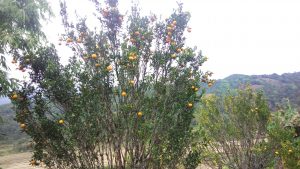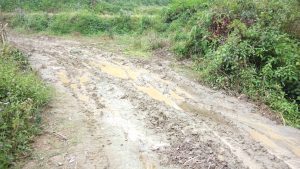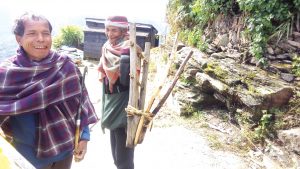By Daiaphira Kharsati
They look like golden balls adorning the trees. The mellow orange skin gleams in the bright winter sun. These are Nongjrong’s treasures, fruits of the farmers’ toiling.
The oranges of Nongjrong in Mawkynrew Assembly constituency are famous across the state. In fact, it is these fruits which have made the village one of the most sought after places in Meghalaya.
The secret behind such abundance of the citruses is the Wah Umngot. A few metres below the village, the river gurgles its way to Jaintia Hills. From atop the viewpoint of Nongjrong, the sight of the Umngot, the paddy fields, oranges and the long winding path that leads people down to the river create an idyllic ensemble. It seems that the river is stretching its hands to mankind.

There are many Khasi folk tales about the Umngot. It is believed that the river is named after the daughter of U’lei Shillong, Ka Ngot. She took up a challenge with her sister, Ka Iam, from which the Umiam derives its name.
Ka Ngot flowed gently in comparison to Ka Iam that rushed noisily. Till this day, the gentle nature of Ka Ngot is alive. A benevolent beauty, the river gives the much needed water to oranges and paddy fields of Nongjrong and other villages it travels through.
Oranges from Nongjrong are regarded as one of the best. The fruits grow till April and are marketed to Ummulong, Iew Pynsing at Wahiajer, West Jaintia Hills, and Shillong.

Treasured words
Sordar Pynshaiborlang Synjri said a man named Rob Marboh brought orange seeds from Nongjri over four decades ago. Although oranges grew in Nongjrong village prior to the arrival of Marboh people did not care much about marketing the fruits.
Marboh, “a man of foresight”, encouraged villagers to realise the value of the fruits. “You who are still strong and healthy, please nurture and grow this fruit. One day, you will gather wealth when traders will turn to this village and buy at Rs 10 per fruit,” he had said.
“Marboh’s words have come true,” Synjri said.
Now, traders from Jaintia Hills visit the village and transport the fruits. A blessing was the MGNREGS road that the village received that made it easier for people to transport the oranges.
Synjri informed that the government departments were willing to help but the villagers were not forthcoming. “But with time, people are becoming more receptive and hence, they are getting assistance from departments of Soil, Water, Horticulture and Agriculture.”
The oranges do suffer from citrus decline, a type of disorder that is often fatal for the orange trees, and probably that is something that the Umngot cannot help.
Tourism potential
Besides the treasured fruits, Nongjrong has the potential to become a popular tourist destination.
Synjri said though he wants to elevate Nongjrong as a tourist site he does not want commercial tourism. “We want people interested in research and other academic purposes to visit the village. The locals are being taught about prospects of homestays as well,” he added.
The village has a confluence of rivers and the scenic beauty is mesmerising. If one stands at Nongjrong viewpoint, a panoramic view of the rivers will leave one in awe.
The beauty lies in its rivers — the Lytang, the Umngot and the Um Tangphar. While the Um Tangphar flows through one side of the hill on which Nongjrong sits, the Umngot flows through the other.
The Lytang meets the Umngot in its course and together they flow as the Umngot, which later joins the Um Tangphar that comes down from Kharang village in East Khasi Hills. And so the Umngot flows into Jaintia Hills cutting through the rocky barrier on its way and meandering gently and calmly through the ridges. The sunlight reflects on the crystal clear water that sparkles like diamonds. “The river is like a mirror,” someone had told me once.
On a clear day, one standing at the viewpoint can witness the dancing waters, the greens around them and the paddy fields which turn golden before harvest season and adds another hue to the “painting”, I was told during a visit to Nongjrong.
The rivers pass through several villages and nourish the fields, Synjri explained standing at the viewpoint. Pointing to the hills in the east, he showed the villages of Kut and Puriang in Mawryngkneng.
The day I visited the village was unfortunately rainy and cloudy. Disappointment was inevitable. But a pleasant surprise was waiting for me.
In West Jaintia Hills, he raised his hand to show the villages of Mudur, Niriang, Phlanglyngkhaw and Sohmynting. On the other side are the villages of Mynsang and Synnai Syad in Mawkynrew.

A graduate in History from St Anthony’s College, Synjri has an aim to uplift agriculture in the village and is of the view that educated youth from the village should stop looking for white collar jobs in cities and come back to Nongjrong to lead a better and healthier life.
Synjri thinks ahead of his time. The traditional head of the village has modern visions and he is hopeful to realise them.
“There are many opportunities in agriculture and the use of technology is one of them that will make farming a thriving business in the years to come. It is the right time to turn our eyes towards agriculture. Youth can be trained in food processing and they can start their self help groups,” he said.
It was not an easy walk down to the river from the viewpoint. We made our way to a hillock, which we thought was an easy task. We were wrong. “Are we getting there yet,” was the frequent question during the nearly one-hour walk.
However, the sight of oranges was enough to make us stop. Orange farmers were still working in the fields.
We finally reached the unpaved road and there in front of us was the mighty Umngot. A resident who walked along with us said, “Do take a picture of this road.” His tone was of annoyance and it was justified. The road was slushy thanks to heavy vehicles plying on it.
Speaking about the Umngot, he said that the river waters their fields giving the much needed food security and visitors “will be awestruck if they see the green paddy fields from the view point”.
The villagers have formed a group, Synjuk Iada Wah Umngot, which works towards protecting and preserving the river and its ecosystem. The Synjuk collaborates with the neighbouring Jaintia villages.
The villages are looking forward to a bridge to come up across the river Umngot that will reduce travel time between Nongjrong and Jaintia Hills.
The only word that came to my mind was ‘mystique’. The mysticism in the surrounding, the river and the silence transports one to a different realm. “Another visit is necessary, to hear the gentle sounds of the river wafted in the air, and before the orange fruits complete their cycle of life,” I made up my mind.



